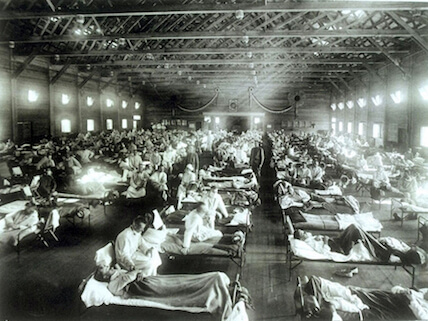Flu patients on a hospital ward at Camp Funston, Kansas, 1918
The Spanish flu pandemic that broke out a century ago was the deadliest in human history. An estimated 50 million to 100 million people died of the disease. Approximately 500 million were infected, nearly one-third of the world’s population at the time. In the United States, some 675,000 Americans died. In 1918 alone, the country’s average life expectancy experienced a drastic 12-year drop.
Influenza (flu) is caused by an extremely contagious virus that attacks the respiratory system. One reason this flu strain, known as H1N1 virus, was so deadly was there were no effective drugs or vaccines to treat it. Unlike other flu outbreaks, the pandemic in 1918–19 at first sickened mostly younger, healthier adults. Many victims died within hours or days, as their skin turned a ghastly blue, their lungs filling with fluid that led to suffocation.
The pandemic clearly was made worse by the fact that World War I was still raging. Because of the war, there was a shortage of physicians and nurses to deal with the outbreak—many of whom themselves caught the flu. Moreover, in many places soldiers were living in crowded barracks or camps. Soldiers who became ill were packed on trains and sent to overcrowded hospitals. Malnourishment and poor hygiene combined to overwhelm medical personnel.
There is still some debate over the flu’s point of origin, as well as over why it spread the way it did. There appear to have been two “waves” of the pandemic—the second worse than the first. Historians, epidemiologists, and other researchers continue to study the pandemic, not only to better understand it, but to help prevent such a deadly scourge from ever happening again. A flu outbreak involving H1N1 did occur in 2009–10, killing at least 12,000 Americans. Today Ebola or Zika or other exotic pathogens get more attention, but our society remains vulnerable to another flu pandemic. Top public health experts routinely rank influenza among the most serious threats we face. The tragic disaster of a century ago still has crucial lessons to be learned.
Photo credit: © U.S. Army/Science Source
Related Links
- Fever Year: Killer Flu of 1918
Book review of new graphic nonfiction on the deadly flu epidemic.
(Source: New York Times, October 7, 2019) - Spanish Flu
(Source: History.com; accessed August 21, 2018) - How the Horrific 1918 Flu Spread across America
(Source: Smithsonian Magazine, November 2017) - Why Was the 1918 Influenza Pandemic Called the “Spanish Flu”?
(Source: History.com, May 22, 2018) - Spanish Flu
(Source: Wikipedia.com; accessed August 21, 2018)




